Having a turtle as a pet can be so much fun as they will be with you for several years. However, unlike any other regular and more common pets like dogs and cats, turtle needs special care. Besides, there are about hundreds of species out there, and not all of them can be domesticated. Some of them grow up to be massive in size, while others are illegal to be kept. Before you decide to get a turtle as a pet, you must also remember that each of the species has its unique requirements pertaining to food, shelter, water, climate, and sometimes even levels of heat and humidity. Therefore, you must indulge in extensive research before bringing one to your home.
The best turtle as pet for beginners
Choosing the best pet turtle can be a challenging task. You should aks yourself how much commitment you are willing to invest into your pet turtle. Also, if you have children, some turtle species are less ideal than others as they don’t all like to be handled. Some species demand a lot of special attention, care and love. Therefore, it often becomes overwhelming. Here are some of the species that are the easiest to take care of for their owners:
If you have no prior experience of keeping a turtle as a pet, you might want to start with a type of turtle that does not require a lot of experience. Another plus is if they look pretty gorgeous too. Here is a list of some of the best turtles for beginners.
Red-eared slider – the best pet turtle?
The red-eared slider turtle is one of the most popular pet turtles in the U.S. They are native to the Southern United States. The name is inspired by the distinctive patch of red behind each of its eyes. Red-eared sliders are quite easy to find and relatively simple to take care of. Also, they do not have an instinct of biting or scratching when touched. Therefore, the red-eared slider turtle is an absolute favorite among kids and are definitely one of the pet turtles that are easiest to take care of. With proper care and maintenance, they live up to 50 or even 70 years.
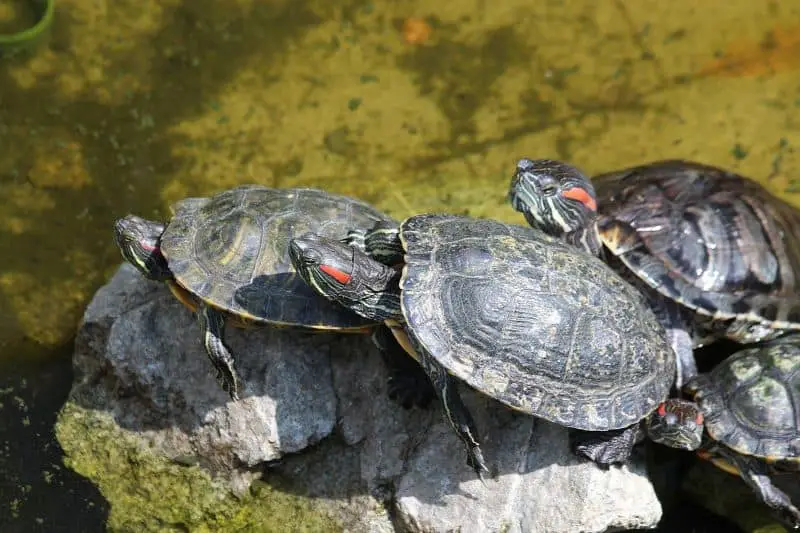
Let’s take a look at some of the quick facts about the red-eared slider turtle:
Appearance and size: As the name suggests, the red-eared slider has a bright red patch behind each of its eye and ear and the overall color of the body is somewhat greenish. They grow up to be fairly big, and you can expect a full-grown adult red-eared slider to be about 12 inches long.
Habitat: The red-eared slider turtle is aquatic turtle. That means that they have to be kept in an aquarium or pond. The preferable size of the aquarium should be at least 30-50 gallons. To keep the water clean at all times, you must make sure that the aquarium has an effective filtration system. The ideal water temperature is 75-86 degrees Fahrenheit. Furthermore, as all turtles or tortoises, the also require a warmer basking area. This is a spot outside of the water under a heating lamp where the turtle can rest and adjust its body temperature.
Diet: Food is of utmost importance, and you must make sure that your red-eared slider is getting the right diet. While you can provide them with commercial foods, you also need to add fresh fruits and green vegetables for a balanced nutrition. Moreover, they also like to munch on crickets and dried shrimps.
Hibernation period: In the wild, the red-eared slider remains in hibernation throughout the winter. Hibernation period starts once the temperature of the water drops below 50 degrees Fahrenheit. In its natural habitat, that is usually around October or November. Sometimes they are even found hibernating underwater. If they are kept indoors, they can also be kept active throughout the winter months if the right temperatures are provided.
More information on red-eared slider care can be found here.
The box turtle – Our favorite pet turtle
The box turtle is another popular pet turtle throughout the world. They have a unique appearance, and unlike most other turtles, they do not live in water and do not require a pond or aquarium. Their name comes from their ability to completely hide inside their high dome-like shell. Their lower part of the shell, the plastron, can be completely closed up with two hinges which does not allow even an ant to get inside the shell. The Eastern Box turtle is one of the most common types of turtles found in the USA. With the right care, they can live up to more than 50 years.
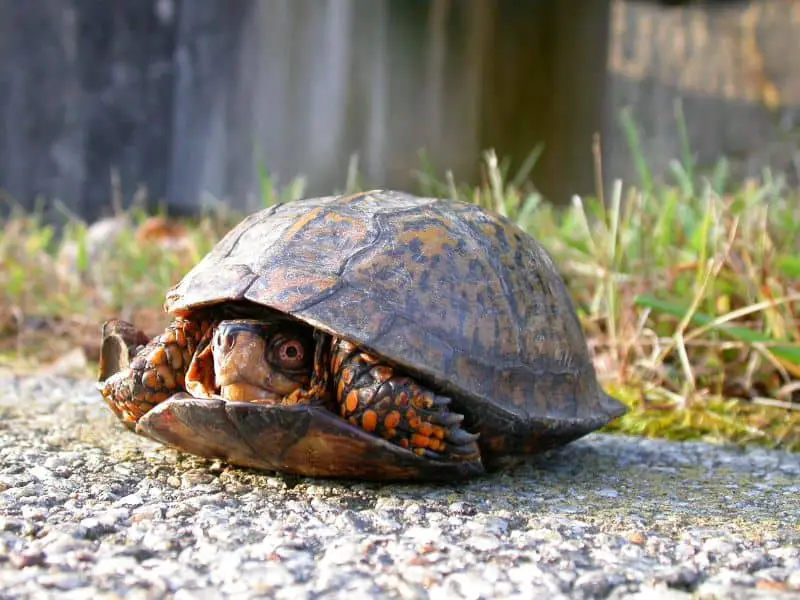
However, they are a rather solitary turtle and do not like to be handled too much. If you are looking for the ideal pet turtle for younger children, the box turtle may not be the right choice for you.
Let’s take a look at some quick facts:
Appearance and size: Unlike common turtles, box turtles do not have webbed feet, and they have a high-domed shell. A fully grown adult can grow up to six inches in length. Among the various species, the Eastern box turtle and the Ornate box turtle are the most commonly found in the pet trade. They both have colorful yellow markings on their shell.
Habitat: Unlike most other turtles, box turtles live on land. Therefore, they do not need an aquatic environment to thrive and grow. However,they need a small pool or shallow bowl for drinking and soaking. The temperature in their habitat needs to be around 70-75°F (21-24°C) and they also need a warmer basking spot of around 85°F (31°C). A humidity level of around 60% must be maintained. This can be achieved by spraying water on the substrate every day. If the environment is too dry, the box turtle will become prone to respiratory problems, dry eyes and other health issues.
Diet: Box turtles are omnivorous, and that leaves you with a wide range of options. You can prepare their daily diet with green vegetables, insects, worms, and fresh fruits. Overall, their diet should consist of around 50% proteins and 50% vegetables, leafy greens and fruits. Provide clean and fresh water every day as they defecate in the water.
Hibernation period: Box turtles like to burrow into the ground to hibernate if the temperatures fall in autumn. However, if kept indoors and higher temperatures, they will skip hibernation, epsecially if they receive about 13 to 14 hours of light each day. If your box turtle is burrowing inside the substrate and starts hibernating, you should either increase the temperatures or keep the habitat in a space where the temperature is between 40-60 degrees Fahrenheit.
Even though they require great care, especially a Three-toed or Eastern box turtle can be a very fun and rewarding pet turtle. Make sure to only buy captive-bred turtles and do never remove any from the wild. You can browse through our site to find more information on box turtle care.
Painted Turtle
Painted turtles are native to North America and can be found from the Atlantic to the Pacific and from southern Canada to northern Mexico. This attractive turtle species gets its name from the myriad of colors on its body. The painted turtle is a popular turtle with beginners and is one of the best turtles as pets. They are, as other turtles, not very social but live in harmony with other species. With the right care, they can live up to 50 years.
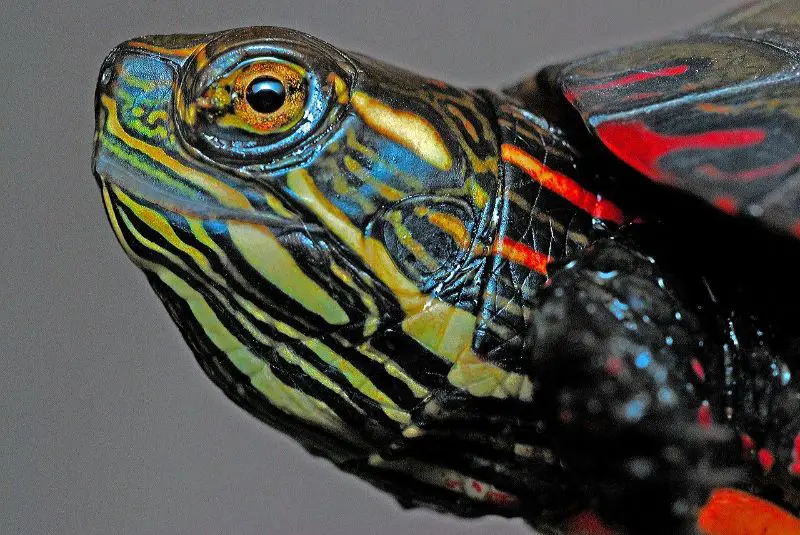
Let us take a look at some of the quick facts about the Painted turtle:
Appearance and size: The painted turtle has bright red, yellow, and green colors all over its body, hence the name. Their beautiful colors make painted turtles a very popular turtle. A fully grown adult can grow up to 10 inches in length.
Habitat: As they are used to live in water, the ideal habitat for a painted turtle should at least have 20 gallons of water for them to swim in comfortably. The temperature range should be between 60 to 90 degrees Fahrenheit. However, even though they are an aquatic turtle species, they also need a warm basking place outside the water like other reptiles. They need to have access to full-spectrum lighting and ultraviolet light for 10 to 12 hours a day.
Diet: You can feed your painted turtle commercial foods along with parsley, crickets, worms, guppies, dandelion, and romaine.
Hibernation Period: Like red-eared sliders, Painted turtles become inactive around October. They tend to go into hibernation when the temperature drops below 50 degrees Fahrenheit. If kept indoors at higher temperatures, they can remain active year round.
More information on painted turtle husbandry can be found here.
Razor-backed Musk Turtle
The Razor-backed musk turtle is native to the United States and can be found from eastern Texas to Mississippi and northward to Southeastern Oklahoma and Southern Arkansas. Although these musk turtles live in and around water, they need to bask in the sun occasionally. The species often lives near fishing docks and near shallow edged rivers. They live up to about 15 to 20 years and grow to a size of 5-6 inches (15 cm).
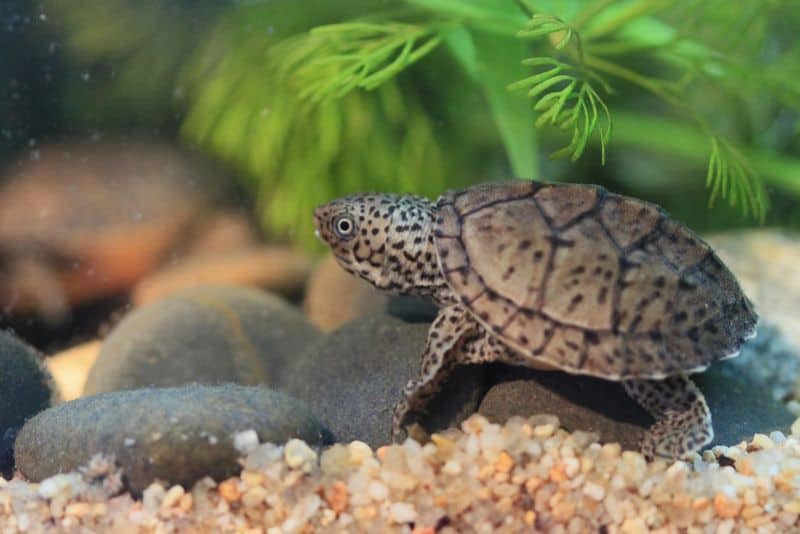
Let us take a look at some of the quick facts about razor-backed musk turtles:
Appearance and size: These musk turtles have a tan or cream-colored body with brown marks drawn over the shell and the body. They usually have a large head and an equally large neck. The sharp beak happens to be the identity of the razor-backed musk turtle. The legs are short, and they have a large keel that goes through the length of the shell. An adult grows up to five to six inches in length.
Habitat: For this aquatic species of turtle, you need to provide a 20-gallon aquarium. However, the larger, the better. It is also essential to provide a basking site for them, which should be around 90°F (32°C).
Diet: The razor-backed musk turtle is carnivorous, and you can feed them commercial pellets, worms, minnows, and insects. Every feeding should also include some vegetables or fruits for a balanced diet.
More information can be found here.
African Aquatic Side Neck Turtle
This unique species is originally from Southern and Eastern Africa. Their face looks like they were constantly smiling. They are also easily available in pet stores and are not endangered – another fact that makes them one of the best pet turtles. The African side neck turtle is very active during the day time and therefore very popular among families with younger children. With proper care, they live up to 25 years.
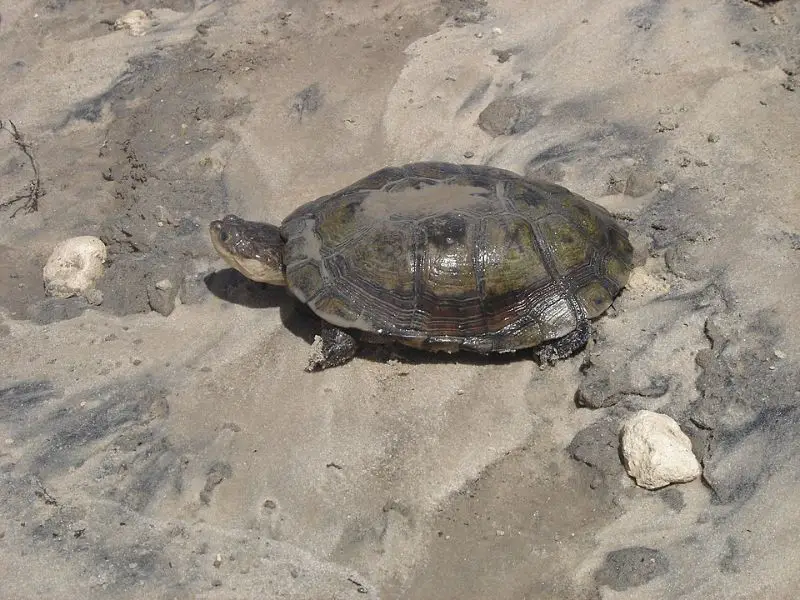
Let us take a look at some of the quick facts about the African aquatic side neck turtle:
Appearance and size: This species is usually dark in color, and the head has brown or olive-colored dark markings. The belly has grey color with some yellow patches. The feet are not entirely webbed, and they have sharp claws. An adult can grow up to 12 inches in length (30 cm).
Habitat: You can keep them inside as well as outside. All you need is a massive 40-gallon water tank, a basking area, and proper lighting set-up and heating. You must keep the water clean by getting a powerful filtration system.
Diet: African side neck turtles are omnivorous, but they especially like to eat meat. Therefore, you can feed them cooked chicken, fish, and beef heart. Still, lots of leafy vegetables should be included into their diets.
Hibernation period: Unlike most American turtles, the African side neck turtles do not hibernate. They are active year-round. Another great plus.
Learn more about the African aquatic side neck turtle here.
Wood Turtle
The wood turtle is another popular pet turtle species that is native to North America. It is a very active turtle that moves a lot and needs both water and land to thrive. Therefore, it is a great pet turtle for people who live in its natural reach in the Northeastern United States and Canada and can provide the animal an outdoor enclosure. The wood turtle lives between 40-60 years if kept at the right conditions.

Appearance and size: The wood turtle is sometimes confused with the Eastern box turtle from their body coloring and appearance. Their limbs are brown and yellow or orange and their shell has a brown-yellow coloring. An adult wood turtle reaches a size between 5.5-8 inches (14-20 cm).
Habitat: The wood turtle is a semi-aquatic turtle. In the wild, they live around creeks, ponds or natural streams. During the colder winter months, wood turtles spend a lot of time around and under water. During the warmer summer months, they become more active and terrestrial.
Diet: Wood turtles are omnivorous like many other turtle species. When kept as a pet turtle, they can be fed with raw lean meat, boiled chicken meat, worms and other insects as well as vegetables and fruits like tomatoes and apples.
Hibernation period: If kept outdoors, wood turtles hibernate during the winter months. They are either hibernating on land or also under water.
More information can be found here.
False Map Turtle
The false map turtle is a North American aquatic turtle. The Mississippi map turtle is a famous subspecies of them. They look gorgeous and are relatively easy to care for – a great plus for all keepers. They usually live between 30-50 years.
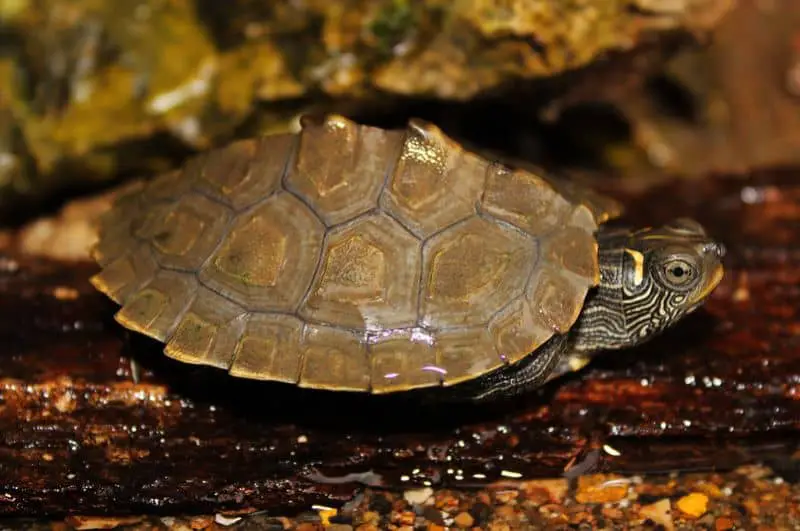
Let us take a look at some of the quick facts about the false map turtle:
Appearance and size: The false map turtles are relatively small, and females are bigger than males. An adult grows between 4 to 10 inches in length. Moreover, they have beautiful contour lines that run down their body and shell as well as a raised saw-like back.
Habitat: As males are smaller in size, they need 20 to 25 gallons aquarium or pond while females need a 75 gallon tank to thrive. The large required size of the enclosure can be an issue for some keepers. The temperature of water should be at least 75 degrees Fahrenheit. They also need a basking spot, where the temperature should be between 85 to 90 degrees Fahrenheit.
Diet: The false map turtles eat varieties of insects, greens, veggies, and commercial turtle food.
More information can be found here.
We hope you found some inspiration for the perfect pet turtle for yourself
With the right decision and extensive research, you can get the best pet turtles that are not only fun to have and are companions for life but are also easy to take care of and less pocket pinching.
